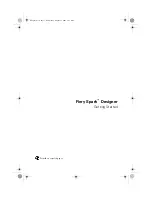
As a consequence of all this, you might experience some problems with a number of
application protocols, such as ICQ, cucme, IRC (DCC, CTCP), and FTP (in PORT
mode). Web browsers, the standard FTP program, and many other programs use the
PASV mode. This passive mode is much less problematic as far as packet filtering and
masquerading are concerned.
15.3 Firewalling Basics
Firewall is probably the term most widely used to describe a mechanism that provides
and manages a link between networks while also controlling the data flow between
them. Strictly speaking, the mechanism described in this section is called a packet filter.
A packet filter regulates the data flow according to certain criteria, such as protocols,
ports, and IP addresses. This allows you to block packets that, according to their ad-
dresses, are not supposed to reach your network. To allow public access to your Web
server, for example, explicitly open the corresponding port. However, a packet filter
does not scan the contents of packets with legitimate addresses, such as those directed
to your Web server. For example, if incoming packets were intended to compromise a
CGI program on your Web server, the packet filter would still let them through.
A more effective but more complex mechanism is the combination of several types of
systems, such as a packet filter interacting with an application gateway or proxy. In
this case, the packet filter rejects any packets destined for disabled ports. Only packets
directed to the application gateway are accepted. This gateway or proxy pretends to be
the actual client of the server. In a sense, such a proxy could be considered a masquerad-
ing host on the protocol level used by the application. One example for such a proxy
is Squid, an HTTP proxy server. To use Squid, the browser must be configured to
communicate via the proxy. Any HTTP pages requested are served from the proxy
cache and pages not found in the cache are fetched from the Internet by the proxy. As
another example, the SUSE proxy suite (
proxy-suite
) provides a proxy for the FTP
protocol.
The following section focuses on the packet filter that comes with SUSE Linux Enter-
prise Server. For further information about packet filtering and firewalling, read the
Firewall HOWTO included in the
howto
package. If this package is installed, read the
HOWTO with
less /usr/share/doc/howto/en/txt/Firewall-HOWTO.gz
Masquerading and Firewalls
173
Summary of Contents for LINUX ENTERPRISE DESKTOP 11
Page 1: ...SUSE Linux Enterprise Server www novell com 11 March 17 2009 Security Guide...
Page 9: ...32 7 Managing Audit Event Records Using Keys 433 33 Useful Resources 435...
Page 10: ......
Page 29: ...Part I Authentication...
Page 30: ......
Page 55: ...Figure 4 2 YaST LDAP Server Configuration LDAP A Directory Service 41...
Page 126: ......
Page 127: ...Part II Local Security...
Page 128: ......
Page 158: ......
Page 173: ...Part III Network Security...
Page 174: ......
Page 194: ......
Page 197: ...Figure 16 2 Scenario 2 Figure 16 3 Scenario 3 Configuring VPN Server 183...
Page 210: ......
Page 228: ......
Page 229: ...Part IV Confining Privileges with Novell AppArmor...
Page 230: ......
Page 274: ......
Page 300: ......
Page 328: ......
Page 340: ......
Page 342: ......
Page 386: ......
Page 387: ...Part V The Linux Audit Framework...
Page 388: ......
















































